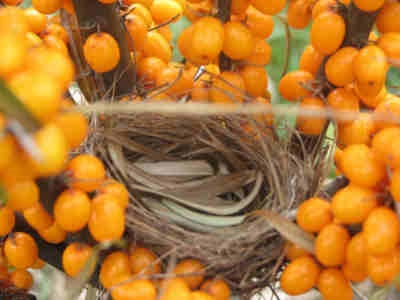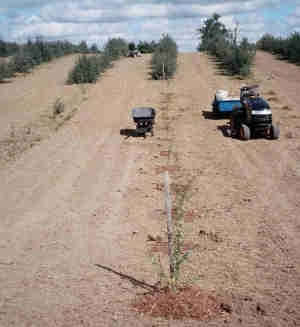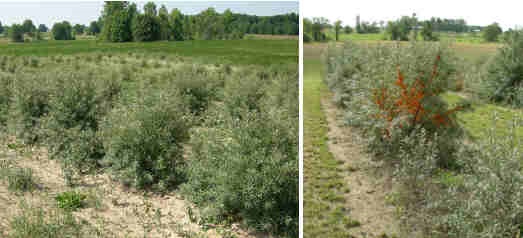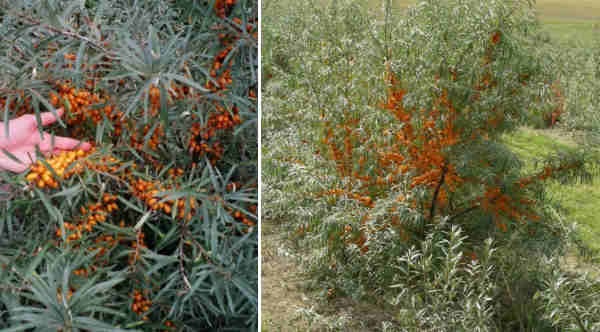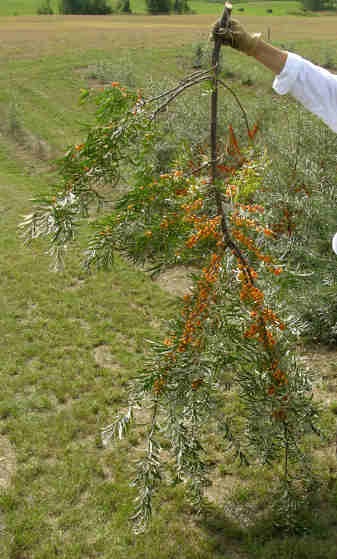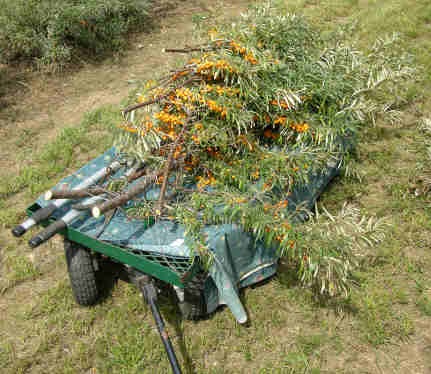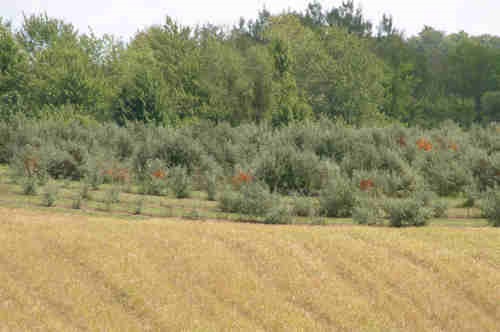Introduction to sea buckthorn
Information on sea buckthorn , its uses, characteristics and management requirements.
General information
Latin Name
- Hippophae rhamnoides L.
Family
- Elaeagnaceae
Common names
- Sea buckthorn, Siberian pineapple, Sea Berry, Sandthorn or Swallowthorn.
Habitat
- It is native from northwestern Europe, through central Asia to the Altai Mountains to western and northern China and the northern Himalayas.
Historic uses
- Used in ancient Greece as a fodder for horses to promote weight gain and a shiny coat. In fact, the generic Latin name "Hippophae" literally translates to "shiny horse".
- Sea buckthorn has been used for centuries in both Europe and Asia as food; and for its pharmaceutical properties.
- Anecdotal reports indicate sea buckthorn was used in ancient times to:
- Lower fever, reduce inflammation, counteract toxicity and abscesses, and clean the lungs.
- Treat colds and coughs.
- Treat tumours and growths, especially of the stomach and the oesophagus.
Current uses
Functional food
- Juice from sea buckthorn berries is a common drink in many parts of Asia and Europe. The juice is very high in protein, vitamins C and E, and organic acids.
- The leaves, either fresh or dried, can be steeped to yield a nutritional tea.
- The leaves, young branches and fruit pulp can be used as animal fodder.
Medicinal
- Topical application of sea buckthorn oil has been reported for skin therapy including sun, heat, chemical and radiation burns, eczema and poorly healing wounds. Russian cosmonauts used sea buckthorn cream for protection from cosmic radiation.
- Oil from the sea buckthorn fruit is rich in vitamin E, carotenoids, phytosterols and essential fatty acids, all of which have beneficial medicinal properties for the treatment of internal and topical maladies.
Agronomic and environmental
- Sea buckthorn is a remarkably hardy bush that rapidly develops an extensive root system capable of fixing nitrogen. Thus, it is suitable for growth on marginal soils, eventually improving them to where they can support the growth of other plants. It is quite tolerant of salt-spray adjacent to highways. Sea buckthorn has been used for:
- Soil erosion control and land reclamation projects.
- Wildlife habitat enhancement (figure 1) and farm stand protection.
- Ornamental bushes.
Plant characteristics
The Sea buckthorns are deciduous shrubs that typically range from 0.5 to 6 m in height with equivalent spread, but may reach up to 18 m in central Asia. The staminate trees are more erect than the spreading pistillate trees. It naturally tends to sucker forming thickets if not properly maintained. They can survive temperatures as low as - 40°C, and are both drought and salt tolerant. Sea buckthorns require full sunlight for good growth and cannot tolerate shady conditions near larger trees. The branches are dense, stiff, and very thorny with both terminal and axillary twig spines. The linear or lanceolate shaped leaves, which are 3 to 8 cm long and less than 7 mm wide, are dark grey-green on the upper surface and a distinct pale, silvery-grey on the lower surface. Sea buckthorn is dioecious, with separate male and female plants. Flowers emerge prior to the leaves, are localized to the 2nd year-old wood, and occur in small racemes in the leaf axils along the entire length of the branch. Pollination of the female flowers occurs in mid-May, and is entirely dependent on wind to spread pollen from the male flowers. Fruit ripening occurs about 100 days after pollination. Sea buckthorn fruit can vary in both shape and colour, but are typically globose to egg-shaped berries ranging from yellow to bright orange in colour. The combination of fruit shape and size, together with the contrast between the colour of the fruit and leaves, contributes to the ornamental value of this plant.
Parts used
- Leaves and young branches.
- Berries.
Agronomic practices
Agricultural zone
- Woody shrub to small tree hardy to Zone 3 (- 40°C).
Seed germination
- Will germinate in 3 to 10 days after stratification to break dormancy depending on germination temperature.
- Stratification for 90 days at 3 to 5 °C under moist conditions are required to achieve good germination when sown in the spring or in the greenhouse.
- Fresh seed can be sown directly in the field in the fall covered with 5 mm of soil.
Propagation
- By seed, but seedling will not be identical to female plant, and may be male.
- By softwood cutting — simple, inexpensive, and highly successful
- By hardwood cutting — simple, inexpensive, and moderately successful.
- Root cuttings will propagate quite readily.
- By suckering — simple, inexpensive, but suckers have poor root mass and may suffer transplant shock.
Light
- Full sun.
Soil type
- Sea buckthorn is adapted to a wide variety of soils, and will grow on marginal land including sandy, gravely soils with poor nutrient and water retention capacities. Sea buckthorn thrives on well drained, light to medium sandy loam.
- Has a moderate tolerance for saline soils.
- A soil pH between 6–7 is optimum.
Moisture needs
- Although drought tolerant, a minimum of 400 mm of annual precipitation is required to ensure good fruit yield. Fruit set at an orchard near Wingham, Ontario occurred 2 weeks earlier in 2006 compared to 2005. For the period from May 1st to September 1st, both growing degree days (1516 vs. 1362) and crop heat units (2366 vs. 2162), were higher in 2005 compared to 2006, but rainfall was significantly higher in 2006 (335 mm vs. 239.6 mm). The additional rainfall in 2006 likely contributed positively to both the early fruit set and increased yield.
Spacing
- Orchard design is dependent on whether the fruit will be harvested mechanically or by hand. Typical orchards have about 600 to 1000 plants per acre, with 1 male for every 7 female plants.
Harvest
When only a few trees are grown, the berries can be readily harvested by hand, requiring about the same amount of effort as harvesting raspberries. Although the thorniness of the sea buckthorn bushes can be a problem, young plants may be relatively thorn free. Some thornless varieties are currently available, and future breeding efforts should increase their numbers. As the number of trees in the orchard increases, so does the work required for harvesting the berries. Figures from China indicate that up to 1500 person hours per hectare are required for hand harvesting. Hand harvesting at the Wingham area orchard suggests the time to hand harvest per hectare may be significantly higher than 1500 hours, especially when trying to harvest intact berries. The fruit are strongly attached, and are not easily stripped from the branches. Experienced pickers were able to harvest intact fruit at rates of 1–1.5 kg per hour. The difficulty of removing the fruit from the tree diminishes as the season progresses. Unfortunately, fruit quality also decreases over this same period, so optimum times for harvest will need to be identified for individual growing areas. Successful commercial operation of a sea buckthorn orchard will ultimately require the development and implementation of some type of mechanical harvester. Several types have been developed, including a vibratory shaker invented in Saskatchewan. As with any crop grown for nutraceutical, medicinal or culinary use, post-harvest handling of sea buckthorn berries should conform to approved Good Agricultural Practices standards. After cleaning, the berries should be processed as soon as possible, but may be either stored at low temperature (4 to 6°C), or flash frozen if immediate processing is not feasible. The shelf life of berries stored at low temperature can be up to 2 weeks. Berries maintain their shape when thawed after freezing. The fruit harvested from the Wingham orchard is currently being used in both fresh and frozen products which are sold at a farmers market near Huntsville. The fruit is processed into a variety of products, including jelly, juice extracts, nectar salsa and bread made from the pulp and seeds following juice extraction. Young leaves have been dried and ground for use as a tea.
Other considerations
As with any alternative crop, new growers should educate themselves on the cost of production and the market potential of sea buckthorn. Furthermore, prior to making any claims about the nutraceutical or medicinal properties of sea buckthorn, growers must ensure that these claims fall within the regulations established by the Natural Health Products Directorate of Health Canada.
References
- Li, T.S.C and Beveridge, T.H.J. 2003. Sea Buckthorn (Hippophae rhamnoides L.): Production and Utilization. NRC Research Press, Ottawa.
- Zeb, A. 2004. Important therapeutic uses of sea buckthorn (Hippophae): A review. J. of Biological Sciences 4(5): 687–693.
This infosheet was authored by Jim Todd, Transition Crop Specialist, Crop Technology Branch, Ontario Ministry of Agriculture, Food and Rural Affairs.
